ASUS VG236H 23-inch 3D Display Review: 120Hz is the Future
by Brian Klug on August 7, 2010 2:48 AM ESTColor Quality
Now let’s get to the meat of the display characteristics. As usual, we report two main quality metrics: color accuracy (Delta-E) and color gamut. Color gamut refers to the range of colors the display is able to represent with respect to some color space. In this case, our reference is the AdobeRGB 1998 color space, which is larger than the sRGB color space. So our percentages are reported with respect to this number, and larger is generally better.
Color accuracy (Delta E) refers to the display’s ability to display the correct color requested by the GPU and OS. The difference between the color represented by the display, and the color requested by the GPU is our Delta-E, and lower is better here. In practice, a Delta E under 1.0 is perfect - the chromatic sensitivity of the human eye is not great enough to distinguish a difference. Moving up, a Delta E of 2.0 or less is generally considered fit for use in a professional imaging environment - it isn’t perfect, but it’s hard to gauge the difference. Finally, Delta E of 4.0 and above is considered visible with the human eye. Of course, the big consideration here is frame of reference; unless you have another monitor or some print samples (color checker card) to compare your display with, you probably won’t notice. That is, until you print or view media on another monitor. Then the difference will no doubt be apparent.
As I mentioned in our earlier reviews, we’ve updated our display test bench. We’ve deprecated the Monaco Optix XR Pro colorimeter in favor of an Xrite i1D2 since there are no longer up-to-date drivers for modern platforms.
For these tests, we calibrate the display and try to obtain the best Delta-E we can get at both 200 nits of brightness for normal use, and 100 nits for print brightness. We target 6500K and a gamma of 2.2, but sometimes the best performance lies at native temperature and another gamma, so we try to find what the absolute best performance could be. We also take an uncalibrated measurement to show performance out of the box using either the manufacturer supplied color profile, or a generic one with no LUT data. For all of these, dynamic contrast is disabled.
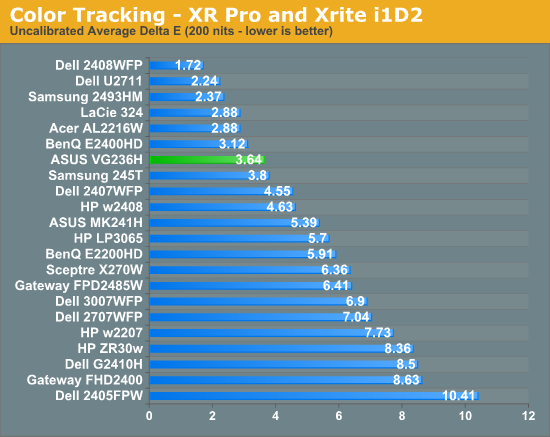
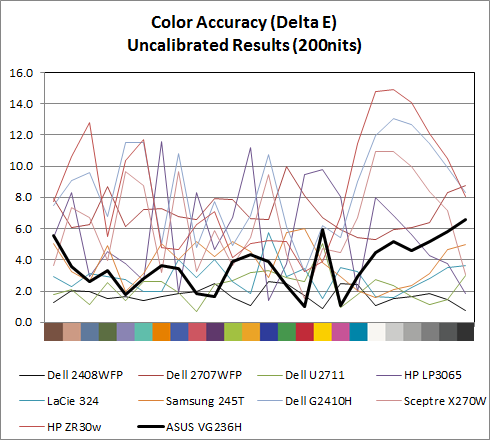
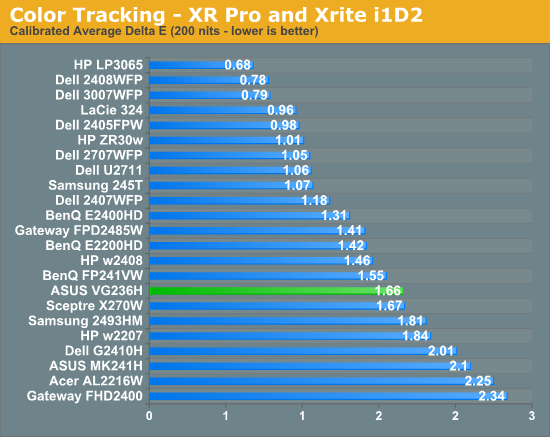
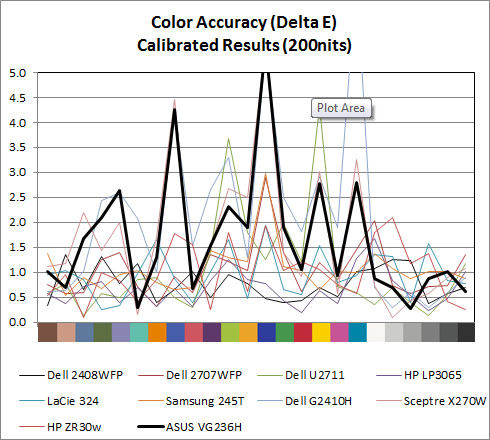
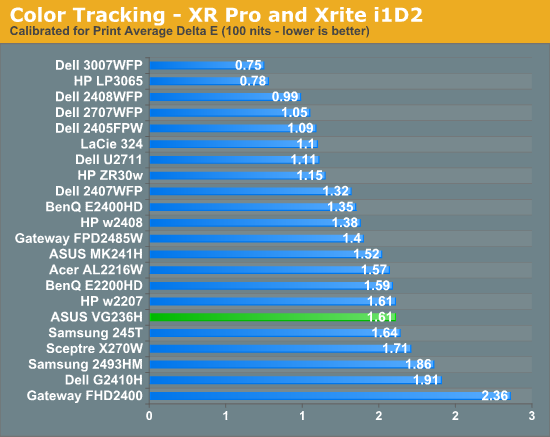
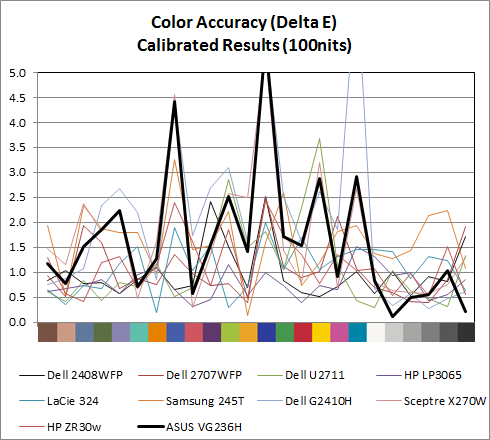
Performance uncalibrated, entirely out of the box is actually very good, at a respectable 3.64. When I first started working on the VG236H I didn’t notice any color tints or weird hues, and upon measuring the display, found the white temperature to be almost exactly 6600K, very close to our 6500K target for calibration. This is nice to see out of the box. For gamers interested in ballpark color reproduction but not professonal level absolute colormetric reproduction, this is adequate.
Moving on, at 200 nits the VG236H gets a bit more accurate, down to 1.66, but still isn’t quite as good as an IPS panel. Still, not bad for a TN. Going down to 100 nits, we get a bit better, moving down to 1.61, but still not that elusive sub 1.0 the highest quality displays can deliver. What about gamut?

As expected, gamut is right around where we’d expect it to be for the TN, sRGB display. Interestingly enough, the OSD controls do have an sRGB mode, though I don’t think it’s as necessary as it would be on say a wide gamut display. But it’s there for certain.











121 Comments
View All Comments
user72 - Saturday, August 7, 2010 - link
I have some molecular modeling programs that use OpenGL QuadBuffer for 3D rendering. Do you know if this monitor is compatible with QuadBuffer? Thanks!Sp12 - Saturday, August 7, 2010 - link
Until I can get 120hz IPS technology I'm unimpressed. 120hz is in no way worth it for the dithering and inconsistent colors TN brings. Especially if it comes at a premium like that.I may be waiting forever until blue phase or autostereoscopic displays come around.
http://en.wikipedia.org/wiki/Blue_Phase_Mode_LCD
http://en.wikipedia.org/wiki/Autostereoscopy
Soldier1969 - Saturday, August 7, 2010 - link
1080 monitors suck after having 1920 x 1200 since Jan of 2007 I will never go backwards in resolution. When they make a 2560 x 1600 LED backlit 120hz panel I'll get one but these 1080 ones cater to the poor folk.Daeros - Saturday, August 7, 2010 - link
This review just highlights why I still use a pair of HP 1230 21" crt monitors. Sure, they weigh about 70lbs each, but they are like 6 years old and have no problem running at 2048x1536 @ 110Hz . Show me any lcd that can do that. And don't even get me started on gamut or black levels.Zok - Saturday, August 7, 2010 - link
Well, without getting into the old CRT-LCD argument too heavily, my desk can't handle a 30" CRT - size or weight.DarkUltra - Sunday, August 8, 2010 - link
1536x110hz = 169Khz horizontal frequency. That is amazing.. I thoght my lacie electronblue22 III was good at 1440x85hz :)Luke212 - Sunday, August 22, 2010 - link
yeah its a nice story but his crt can only do 91hz at that rez.(140k/1536)
adonn78 - Saturday, August 7, 2010 - link
I think its over priced for a 23 inch monitor. I'd rather get a larger screen than one with features I'll never use such as 3D.DarkUltra - Sunday, August 8, 2010 - link
It's not just the 3D. 120hz give you a much smoother Windows experience, and the lack of RTC artifacts is also good.SunLord - Monday, August 9, 2010 - link
Any monitor over $300 isn't worth buying even fi its 120hz and the newest gimmick to get stupid people to pay more